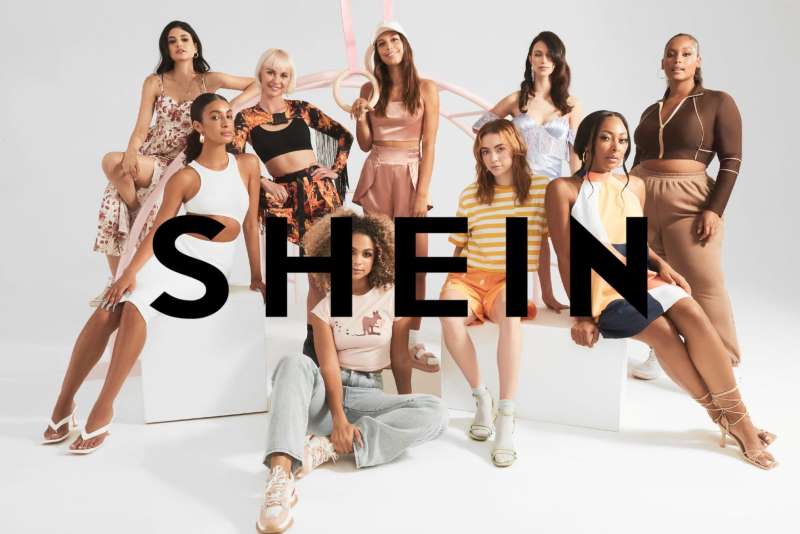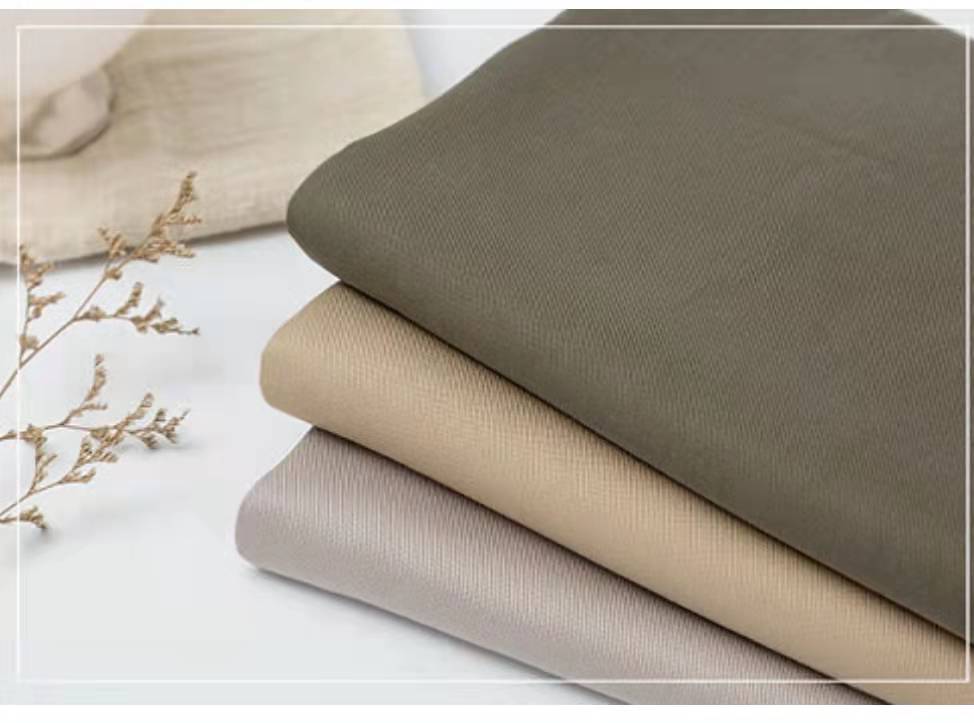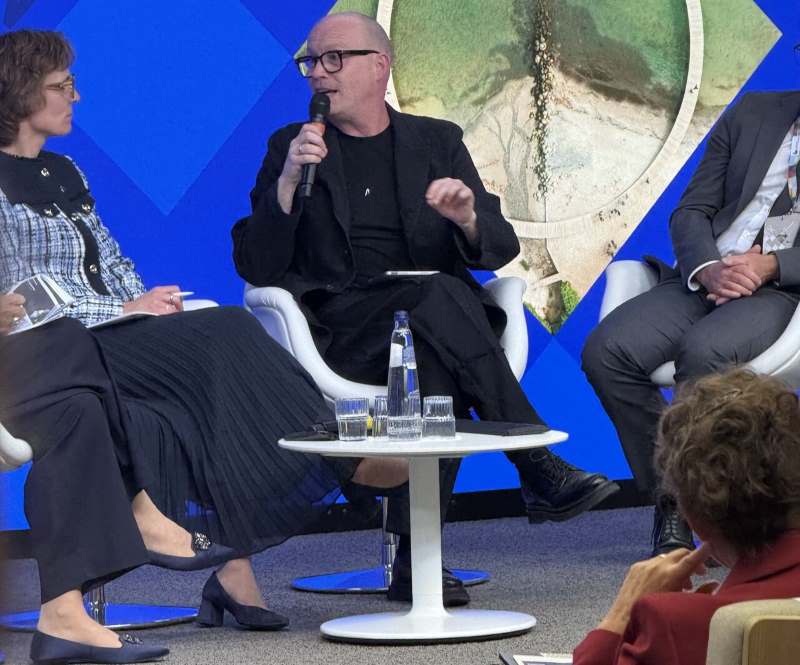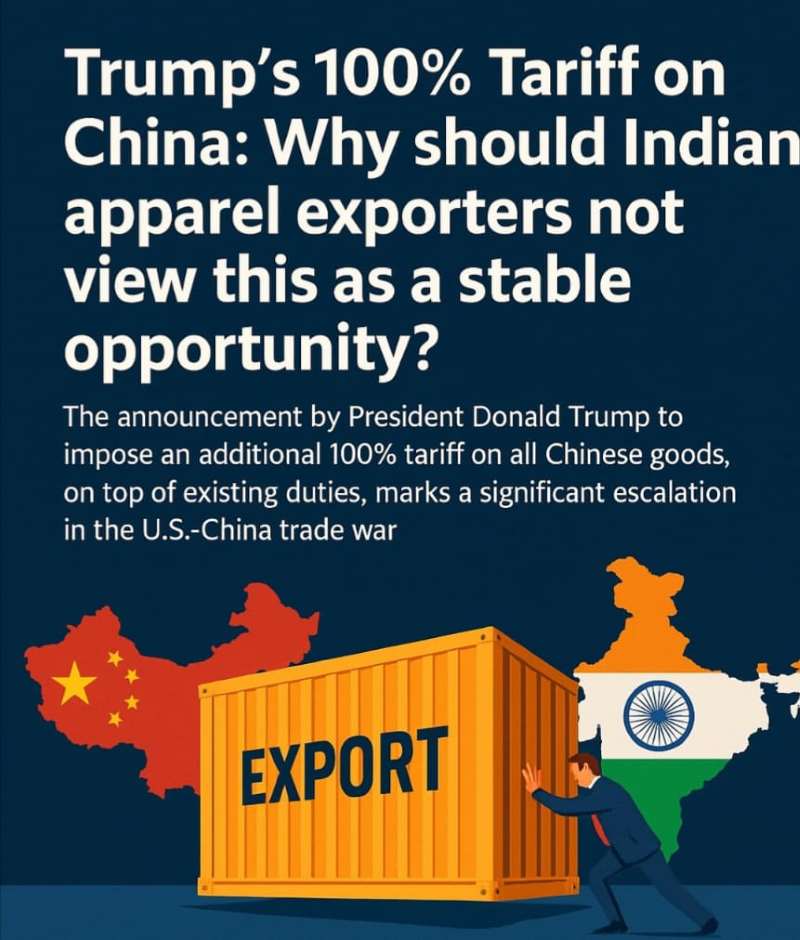The Textile Institute (TI) is set to celebrate a significant milestone at the ITMA Asia+CITME textile machinery exhibition in Singapore later this month.
At Booth B105 in Hall 8, TI will exhibit as a reciprocal member of the British Textile Machinery Association (BTMA), highlighting the strength of their collaboration. The two organizations' long-standing partnership has recently been cemented by the appointment of Jason Kent, CEO, BTMA as new Commercial Vice President, TI. The move brings fresh industry perspective and influence to the role.
Corporate membership of The Textile Institute gives organizations access to an international network of professionals, cutting-edge research, and strategic benefits valued at over $12,700 (£10,000) a year, says Kent
This membership provides a wide range of advantages, including global promotion and visibility, invitations to high-level networking and training events, opportunities for collaboration on industry-led research, professional recognition through chartered qualifications, and access to TI’s publications, data, and R&D resources.
As the only global professional body in this sector with a Royal Charter, the Institute drives the industry forward through high-quality events and training courses that equip professionals for the future, notes Stephanie Dick, CEO, TI. Together with their Corporate Members, the Institute tackles skills gaps, developing practical training solutions, and reaching international audiences.
The Textile Institute is uniquely positioned to help organizations stay competitive, connected, and compliant. Though it was first founded in Manchester in 1910, its mission has always been to be ‘not of Manchester, but international.’ With active sections and special interest groups across the globe, it now serves members in over 60 countries, empowering professionals across every link in the textile supply chain.
Along with major trade bodies like CITI and SGCCI, The Northern India Textile Mills’ Association (NITMA) met officials from the Ministry of Textiles and Chemicals to register their intense opposition against the recommended anti-dumping duty (ADD) on Mono Ehtylene Glycol (MEG), warning the government it would deliver a ‘castatrophic blow to the sector. NITMA cautioned , the duty would devastate the predominantly MSME-based downstream industry, jeopardizing millions of jobs and freezing critical investments.
The industry's primary fear is the massive cost escalation the ADD would cause. The proposed duty is estimated to raise MEG costs by an additional 20 per cent.
This hike will practically force MMF units across India to shut down, stated NITMA. The industry is in such a state of shock and panic that unit owners are ready to hand over the keys to their factories, as they cannot sustain this devastating blow, it added.
The downstream sector is already struggling with uncompetitive raw material prices. Before the Bureau of Indian Standards (BIS) quality control order, domestic polyester staple fiber (PSF) was already 15–20 per cent pricier than what global competitors, such as those in China, paid. The BIS order has since allowed domestic fiber producers to charge a premium of Rs 6–Rs 7 per kg over imported parity. Imposing the ADD on MEG would widen this uncompetitive gap even further, to approximately Rs 10–Rs 11 per kg, severely crippling MSME units.
The associations have called on the government to reject the DGTR recommendation immediately to safeguard the future of the Indian MMF sector.
Indian textile exporters are actively searching for new customers in Europe and offering discounts to their current US buyers. This shift is a direct response to the impact of high US tariffs, which are reportedly as high as 50 per cent, according to industry executives.
In August, Donald Trump, President doubled tariffs on Indian imports, making them among the steepest for any US trading partner. This move has affected a variety of Indian goods, including garments, jewelry, and shrimp.
Trade negotiations between India and the EU have entered a critical stage, with teams working aggressively to meet a year-end goal for signing a free trade agreement.
The EU is currently India's largest trading partner for goods, with two-way trade reaching $137.5 billion in the fiscal year ending March 2024 - an increase of nearly 90 per cent over the last decade. Indian exporters are intensifying efforts to meet the EU's demanding standards related to chemicals, product labeling, and ethical sourcing, textile executives noted.
Exporters are upgrading their production facilities to comply with these requirements, according to Rahul Mehta, Chief Mentor, Clothing Manufacturers Association of India (CMAI). Mehta also added that exporters are keen to reduce their current dependence on the US market.
The US was India's largest market for textiles and apparel in the fiscal year to March 2025, accounting for almost 29 per cent of total exports, which were valued at roughly $38 billion.
Some exporters have already begun offering discounts to retain US customers, states Vijay Kumar Agarwal, Chairman, Creative Group, whose US exports represent a massive 89 percent of its total shipments.
Agarwal warned, if US tariffs continue to hurt business, the company could be forced to lay off 6,000 to 7,000 of its 15,000 workers. Furthermore, after six months, the company may consider moving production to countries like Oman or Bangladesh.
Freudenberg Performance Materials Apparel (Freudenberg Apparel) is significantly expanding its manufacturing footprint in India. On October 14, 2025, the company completed a project involving extension of its Chennai facility, which added 20,000 sq ft of new production space.
This strategic investment aims to drastically improve efficiency and product availability for the rapidly growing apparel sector across India and South Asia. The expansion increases the manufacturing area from 40,000 sq ft to 60,000 sq f and introduces specialized facilities for 100 per cent cotton and 100 per cent polyester interlinings.
Crucially, the new lines enable the local production of items like Chinese-equivalent polyester bi-elastic shirt and polyester woven interlinings. By localizing this production, Freudenberg is cutting lead times for Indian manufacturers from the current 6–8 weeks for imports to just 1–2 weeks. This also offers customers a cost advantage over duty-paid imported goods.
According to Dr Andreas Raps, this expansion marks a milestone in the company’s 27-year journey in India. Jonathan Oh, Senior Vice President, Global Apparel, adds, this investment empowers Indian apparel manufacturers to compete more effectively on the global stage.
The expanded facility is equipped with state-of-the-art machinery that enhances quality assurance. These new capabilities join existing paste dot, 3P printing, and powder dot printing lines at the Chennai site, broadening the locally produced product range.
Freudenberg Apparel also supports the Indian textile industry through technical solution studios in Chennai, Bangalore, and Gurgaon. These studios provide valuable technical consultations, fusing press audits, and other services that complement the company's enhanced manufacturing capabilities.
The winners of the ITMF International Collaboration Awards 2025 will present their projects at the upcoming ITMF&IAF Conference 2025, to be held from October 24-25, 2025 in Yogyakarta, Indonesia. The event will be co-hosted by Indonesia Textile Industry Association(API).
The objectives of the ITMF International Collaboration Awards including recognizing the progress in the area of international collaboration in the textile industry according to the values of the 17 Sustainable Development Goals (SDGs) of the 2030 Agenda for Sustainable Development.
The four winners of the ITMF International Collaboration Award 2025 include: Bursa Uludag University (Türkiye) for their project titled Unlocking Circular Fashion Design Excellence (ReMODE); Far Eastern New Century Corp(Chinese Taipei) for project titled Biological Recycling of PET/Polyester; Hyosung TNC Corporation (Korea) for project ‘From Waste to Worth – The T2T Collaboration Story,’ and Tangshan Sanyou Group Xingda Chemical Fibre Co (China PR) for their project titled, ‘Next-Generation Textile Materials: Pioneering a New Era of Cross-Industry Collaboration.’
Inditex has opened a new Zara flagship store in Las Vegas. The store was opened within the retail area of the iconic Caesars Palace Hotel, specifically in 'The Forum Shops at Caesars Palace,' which is managed by the Simon Property Group.
Spanning three floors, the store showcases the latest collections from Zara's womenswear and menswear lines. Designed by the chain's in-house architecture department, the outlet features a modern, minimalist aesthetic that sharply contrasts with the hotel's ornate, Roman Empire-inspired neoclassical environment. The store’s main design element is a large central atrium that vertically connects the three levels.
Following the design concept introduced at its Madrid flagship in 2022, the Las Vegas store uses a neutral background to put the collections front and center. It also includes dedicated 'showroom' spaces with distinct interior design for items like footwear, bags, the 'Origin' lines, and the 'Zara Athleticz' men's sportswear.
Emphasizing Zara's signature omnichannel experience, the new store offers customers the ability to check real-time inventory online, utilize assisted self-service checkouts, and benefit from a two-hour collection service for online orders. A dedicated order storage silo with a 500-package capacity supports the popular click-and-collect service. In line with its sustainability efforts, the store features an LED lighting system, uses more sustainable construction materials, and is connected to Inditex's 'Inergy' platform for centralized energy monitoring. It also includes containers for cardboard collection and clothing donations.
This opening strengthens Zara's presence in Nevada, adding to its long-running store at Fashion Show Las Vegas. Nationally, this flagship is part of the ‘30 projects’ that Inditex plans to complete in the United States between 2023 and 2025, confirming the US as its largest market outside of Spain.
The rapidly expanding value and lifestyle fashion brand under the Apparel Group, R&B has launched its Fall/Winter 2025 Collection. This collection defines modern seasonal wear by drawing inspiration from three distinct themes: City, Nature, and Classics, offering a blend of versatility, comfort, and current trends for the Middle East and India.
The collection is designed to help everyone express their unique style. For women, the City range delivers bold prints and street-chic silhouettes. The range Nature offers relaxed elegance through calm neutrals while Classics provides refinement with polished tweed jackets and timeless outerwear pieces.
For men, the collection mirrors this energy with varsity-inspired City looks, rugged puffers for the Nature theme, and sophisticated Classics featuring clean knitwear and sleek new PU jackets.
The youth collection for kids offers cool statement sweatshirts in the City line, playful color combinations in Nature, and a modern monochrome twist in Classics.
Refreshing its footwear and accessories range, the brand showcases contemporary designs with elevated details to perfectly complement all the new outfits.
Launched in Oman in 2012, R&B has grown rapidly to operate over 165 stores across eight countries, consistently opening a new location monthly. The brand offers quality, affordable fashion and is backed by its in-house design team, ensuring the collections are always on-trend.
The Fall/Winter 2025 Collection is now available at all R&B stores throughout the Gulf Cooperation Council (GCC) countries and online at randbfashion.com.

In a country known for its deep-rooted retail traditions, discerning shoppers, and a growing emphasis on sustainability, the rise of Shein, China’s ultra-fast fashion powerhouse stands out as one of the most striking retail stories of recent years. Once dismissed as a niche online brand catering to teenage trend-chasers, Shein has now muscled its way into Germany’s e-commerce elite, ranking as the seventh-largest online retailer according to the latest EHI Retail Institute and ECDB data.
The figures reveal a story of speed, scale, and disruption. In 2024, Shein’s German operations generated €1.12 billion in net e-commerce sales, 18 per cent year-on-year growth. It now outranks domestic stalwarts like About You and Shop Apotheke, brands once considered the new generation of German commerce success stories. While Amazon and Otto remain far ahead, with €15 billion and €4.4 billion in sales respectively, Shein’s growth is unmatched, outpacing nearly all of its top-10 peers.
The rise of a challenger
In a German fashion market valued at roughly €65 billion, Shein’s market share of 1.7 per cent may seem modest. Yet, its speed of ascent is unprecedented. It took Zalando, Germany’s homegrown digital fashion titan, more than 15 years to achieve a 4 per cent share. Shein has reached nearly half that in less than a decade and with none of the traditional retail trappings: no warehouses in Germany, no domestic logistics networks, and until recently, no physical presence.
“Shein’s rise represents not just a competitive threat it’s a redefinition of what agility in fashion retail looks like,” says Verena Jung, a retail analyst at EHI. “It’s the embodiment of algorithmic retail where data, not design, dictates what gets produced.” The company’s playbook is built around speed and sensitivity. Rather than producing vast seasonal collections months in advance, Shein operates a ‘test-and-repeat’ model. It launches micro-collections in small batches, gauges customer reactions in real time, and scales only the hits often within days. This responsiveness to trend signals scraped from social media, influencer posts, and search data gives Shein a clear understanding of what its Gen Z shoppers want next.
The power of a generation
At the core of Shein’s success lies a consumer base that is young, digital, and restless. German Gen Z and younger Millennials especially women aged 16 to 30 form the backbone of its market. For them, fashion is less about ownership and more about momentary expression.
A 2025 survey cited by EHI/ECDB found that over 60 per cent of Shein’s German customers discover products through TikTok hauls or Instagram reels. Shein has mastered the art of social commerce, turning viral trends into product catalogs almost overnight. “Shein doesn’t sell clothes it sells participation in a global trend loop,” explains Lisa Becker, a fashion marketing lecturer at Berlin’s Hochschule für Technik und Wirtschaft. “When a microtrend hits, Shein already has it in stock. That’s not luck; that’s data science.”
The company’s pricing strategy, often undercutting competitors by 30-50 per cent adds another layer of appeal. Yet, this affordability comes with volatility. While the average German consumer buys about 1.3 Shein items per year, a smaller, hyperactive segment driven by social validation makes frequent, low-value purchases. This ‘fickle’ core is both a source of Shein’s growth and its biggest vulnerability; loyalty, after all, is fleeting when fashion itself has a 24-hour shelf life.
The sustainability paradox
For a country that prides itself on environmental consciousness, Shein’s runaway success poses a paradox. Germany’s sustainability rhetoric is among the strongest in Europe, yet consumption patterns tell another story.
According to Destatis data, textile waste from private households hit 175,000 tonnes in 2023, while per capita waste rose to around 2 kg annually. More strikingly, exports of old clothes and second-hand textiles reached 462,500 tonnes in 2022, a 55 per cent increase over the past decade.
New EU waste directives coming into force in 2025 will require separate collection of textiles to improve recycling rates. But experts warn that regulation may not address the root problem: overproduction and overconsumption.
Meanwhile, surveys by Mintel and GfK highlight the ‘say-do gap’ in consumer behavior. While nearly 70 per cent of German consumers say sustainability influences their clothing purchases, fewer than 35 per cent actually buy eco-friendly fashion. Cost remains the defining barrier a gap Shein exploits masterfully with its ‘luxury look for less’ promise.
“Shein is the perfect brand for a generation that wants to look conscious but shop cheap,” says Andreas Müller, a sustainability consultant in Hamburg. “It monetizes the contradiction between values and budgets.”
A model under pressure
Shein’s meteoric rise hasn’t come without scrutiny. Allegations of labor exploitation, poor working conditions, and intellectual property violations have trailed the company across markets. In response, Shein has rolled out a supplier code of conduct, pledged to improve transparency, and even launched resale platforms in some European markets to tap into the circular fashion movement.
Yet critics remain skeptical. “Shein’s circularity initiatives are PR patches on a fundamentally linear business model,” argues Johanna Klein, a researcher on sustainable supply chains at the University of Münster. “As long as its profits depend on volume and velocity, sustainability will remain a contradiction in terms.”
Adding to the challenge is a shifting regulatory environment. The EU’s new Ecodesign for Sustainable Products Regulation (ESPR) and forthcoming due diligence laws will force companies to disclose supply chain data and meet environmental standards. For Shein, this could mean either a costly overhaul or a business model towards more localized, compliant production models.
Between disruption and reckoning
For now, Shein’s foothold in Germany looks secure. Its formula data-driven trendspotting, hyper-affordability, and influencer-led marketing has unlocked a level of consumer engagement traditional retailers can only envy. But its long-term survival in one of Europe’s most regulation-heavy markets will depend on its ability to evolve beyond the fast-fashion playbook.
Germany may well be Shein’s toughest test yet: a market where price meets conscience, and where the definition of fashion success is being rewritten in real time. As Shein continues its expansion across Europe, one thing is certain the battle for the wardrobe is no longer between brands, but between values.
In a landmark move poised to reshape the environmental future of fashion, Birla Cellulose launched India’s first next-generation cellulose fiber known as Liva Reviva M. This breakthrough product is made with up to 50 per cent mechanically recycled post-consumer textile waste. The launch marks a bold declaration that fashion must shift away from its traditional linear model.
The world currently generates 92 million metric tons of textile waste annually, a figure the United Nations Environment Program projects will grow by 45 per cent in the next five years. Liva Reviva M arrives as a tangible, scalable, and certified answer to one of the fashion industry’s most critical crises.
Liva Reviva M isn't just another sustainable fiber; it’s the future of fashion itself. We’re not talking about incremental change. We’re talking about rewiring the very DNA of how fashion is made, worn, and reborn, says Manmohan Singh, Chief Marketing Officer, Birla Cellulose.
Liva Reviva M achieves true circularity by blending premium man-made cellulosic fibers with mechanically recycled textile waste. The fiber offers core benefits including 100 per cent plant-origin with major cellulosic content, skin-friendly and breathable, soft to the touch with a fluid drape and certified by both GRS (Global Recycled Standard) and FSC (Forest Stewardship Council).
This fiber is already proving its versatility in real-world use, ranging from premium denims to knitted wear, with leading fashion brands eager to incorporate it into their upcoming collections.
Liva Reviva M provides a rare asset: a commercially viable and technically proven solution. It demonstrates how post-consumer fashion waste - once destined for landfills and incinerators—can now be reborn into high-performance garments, effectively redefining waste as a valuable resource.
With this launch, Birla Cellulose, a global leader in cellulosic fibers and part of the Aditya Birla Group, solidifies its claim as an environment-first pioneer.
UK's leading responsible sourcing trade show, Source Fashion has partnered Redress as their catwalk partner for Olympia London from January 13–15, 2026. This collaboration aims to highlight pioneering designers who are reshaping the fashion industry through circular and sustainable design.
Based in Hong Kong, Redress is an Asia-focused environmental NGO dedicated to speeding up the transition to a circular fashion industry. It achieves this by educating and empowering designers and consumers to reduce the negative environmental impact of clothing.
At the core of their work is the Redress Design Award, the world’s top sustainable fashion design competition. The award has created a global network of over 300 emerging designers who specialize in circular and waste-reducing practices. This shared focus on innovation, education, and real-world change makes Redress an ideal partner for Source Fashion.
For Source Fashion's January 2026 event, Redress will select two to three Redress Design Award alumni to headline the catwalk. Their curated show will emphasize innovation, circular design thinking, and a firm commitment to environmental impact reduction.
The dynamic catwalk will run three times a day. It will offer a visual narrative demonstrating how responsible design and creative excellence can merge to redefine fashion's future.
Suzanne Ellingham, Director, Source Fashion, says, this partnership marks an exciting new chapter for the show's catwalk. Redress has been instrumental in nurturing some of the most forward-thinking designers working in sustainability today. Their alumni prove that creativity and responsibility are not opposing forces - they’re the foundation of fashion’s future, she notes.
Christina Dean, Founder of Redress, states, this partnership with Source Fashion creates the perfect stage to show that sustainable fashion isn’t just a passing trend, it’s the future. It proves, circular design can be innovative, beautiful, and commercially viable, she adds.
The Source Fashion Catwalk will feature responsibly produced collections, trend-led designs, and cutting-edge innovation three times daily. Each show will tell a compelling story of sustainability in action, inspiring buyers with practical ideas they can implement directly after the show.
- 1
- 2
- 3
- 4
- 5
- 6
- 7
- 8
- 9
- 10
From satin to smart textiles, the rise of FDY in a changing market
In the complex world of polyester filament yarns, where POY (Partially Oriented Yarn) is the foundation and DTY (Drawn Textured... Read more
Polyester’s reign vs. Lyocell’s strain, can green fibers survive?
The recent job cuts announced by Lenzing, a pioneer in sustainable cellulosic fibers, are a stark reflection of the complex... Read more
Indian Textile and Apparel Exports Hit Hard in September: As US tariffs take hol…
The Indian textile and apparel industry has shown the first clear signs of being impacted by the new US tariffs,... Read more
Fast, cheap, unstoppable, Shein shockwave hits Germany’s fashion retial
In a country known for its deep-rooted retail traditions, discerning shoppers, and a growing emphasis on sustainability, the rise of... Read more
Europe’s Circular Turn: The Danish vision shaping a new industrial era
In a speech that captured both urgency and ambition, Danish MEP Rasmus Nordqvist stood before an audience of European policymakers,... Read more
“The US government’s economic data makes no sense. It’s a con.” says David Birnb…
“The US government’s economic data makes no sense. It’s a con,” declares David Birnbaum, strategic planner for the global garment... Read more
India's fiber sector spins a new thread of growth
India's clothing fiber sector is on the cusp of a revolutionary decade, moving beyond its traditional identity as a cotton... Read more
Global Supply Chain Earthquake: The 100% ‘Trump Tariff’ and the scramble for Chi…
The imposition of an additional 100% tariff on all Chinese goods by President Donald Trump—a move that underscores the fickleness... Read more
Trump's 100% Tariff on China: Why should Indian apparel exporters not view this …
The announcement by President Donald Trump to impose an additional 100% tariff on all Chinese goods, on top of existing... Read more
Yarn Expo Autumn 2025: A premier international platform for the yarn industry
Yarn Expo Autumn 2025 concluded a highly successful run, firmly establishing its position as the premier international platform for the... Read more











